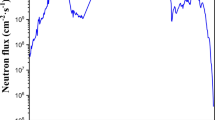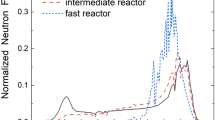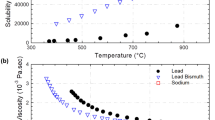Abstract
After the lead-bismuth coolant flows through the core area of the lead-bismuth fast reactor and is irradiated by neutrons, the radionuclide Polonium-210 will be produced. Polonium-210 has a half-life of 138 days and releases alpha particles during decay. With certain volatility, Polonium-210 will pose a potential threat to the environment. Therefore, Polonium-210 is one of the key contents of radiation environmental impact assessment of lead-bismuth reactor. The calculation model of Polonium-210 is established according to the metabolic mechanism of Polonium-210 in the coolant. According to the Polonium-210 calculation model, the generation, decay and migration laws of Polonium-210 in the whole life were analyzed, and the influence of extraction rate on the saturation of Polonium-210 was calculated. The results show that, taking a 20MWth lead-bismuth reactor as an example, in the case of no extraction, Polonium-210 reaches saturation in the fifth year of reactor operation, with a saturation activity of 3.15E + 15Bq. With an extraction efficiency of 90%, Polonium-210 will reach saturation on the 60th day after the reactor starts operating, with a saturation activity of 3.83E + 10Bq. The calculation results can provide a reference for the research on the distribution of Polonium-210 in the coolant.
You have full access to this open access chapter, Download conference paper PDF
Similar content being viewed by others
Keywords
1 Introduction
Lead-bismuth fast reactor uses lead-bismuth alloy as coolant. Lead-bismuth coolant has the following natural characteristics: high melting point, inactive chemical properties, vacuolar reactivity is negative, etc. Lead-bismuth alloy is chemically inert with fuel, low alloy steel, water and air. In addition, lead-bismuth has higher boiling point, Therefore, compared with pressurized water reactor and sodium-cooled fast reactor, the safety has the potential to improve, and it is expected to simplify the reactor structure and improve the economic model. Based on the inherent safety of lead-bismuth alloys, the Fourth Generation Nuclear Forum (GIF) lists the lead-based fast reactor as one of the six advanced nuclear systems with the most potential for development.
The biggest problem with the lead-bismuth alloy as a coolant is the activation of Polonium-210, a volatile alpha emitter, during reactor operation. In the case of loss of integrity of primary circuit boundary and leakage of coolant, Polonium-210 will quickly adsorb on aerosols or dust in the external air, and then settle into soil and surface water from the air, causing internal exposure to the human body through breathing, drinking, or wound infection. Therefore, the yield of Polonium-210 is one of the important contents of Lead-bismuth reactor nuclear power.
With regard to Polonium-210, in the occupational exposure regulations of the Russian NRB-99, for professional personnel, annual inhalation activity less than 6.7E+3Bq/year, and inter-process air activity concentration less than 2.7 Bq/m3. For the public, the annual inhalation activity is less than 2.5E+2Bq/year, and the activity concentration in the air is less than 3.4E–2Bq/m3. Therefore, accurate calculation of Polonium-210 yield is very important. Based on the mechanism of Polonium-210 generation, migration and decay in lead-bismuth fast reactor, an equilibrium equation was established for Polonium-210 metabolism in coolant. The yield of Polonium-210 was calculated and analyzed, and the effect of extraction efficiency on the saturation of Polonium-210 was analyzed.
2 The Production of Polonium
In the operation process of the lead-bismuth reactor, the lead-bismuth coolant is irradiated by neutrons, and the nuclide Bismuth-209 first generates Bismuth-210, which then decays into Polonium-210 by β. Polonium-210, is highly toxic, highly volatile, and has a half-life of 138.4 days. It decays to form a stable nuclide Polonium-206 and releases 5.35 meV energy, while emitting low-intensity gamma rays.

It is found that Polonium-210 mainly exists in pure Polonium-210 and Lead polonium, with the proportion of 0.2% and 99.8%.When lead-bismuth comes into contact with air, it reacts with water vapor in the air to form radioactive aerosols and hydrides of volatile Po. As a result, protective gas is usually placed on top of the reactor lead bismuth coolant to insulate the lead bismuth coolant from the air. Argon is generally used as a protective gas. During operation of the reactor, Polonium-210, the activation product of the coolant lead and bismuth, migrates to the protective gas. When the gas tightness of the reactor cap occurs, Polonium-210 and the protective gas will leak out to the outer space (Fig. 1).
3 Calculation
3.1 Model
The Polonium-210 in the lead-bismuth coolant, produced by the decay of Bismuth-210 generated by Bismuth-209 activation, disappears in its own decay, extraction and evaporation. Therefore, the equilibrium equations for Bismuth-210 and Polonium-210 in lead-bismuth are as follows:
In the formula above, σ is the microscopic reaction cross section of Bismuth-209 (n, γ) Bismuth-210, ф is neutron flux rate, NBi is the nucleon density of bismuth in the coolant, λ is the decay constant of Polonium-210, NPo is the nuclear density of Polonium-210, ε is the extraction efficiency, v is the mass flow rate of lead and bismuth in the coolant, MPbBi is the total mass of lead and bismuth, Г is the evaporation rate of Polonium-210 from lead and bismuth into protective gas.
According to Formula 1, the radioactive activity of Bismuth-210 in lead-bismuth is derived as:
If it is not extracted during the process, then f is 0, Polonium-210 and its radioactivity is:
If extraction is set in the process, the radioactive activity of Polonium-210 is:
Because lead-bismuth is covered with protective gas argon, Polonium-210, the activation product of the coolant lead-bismuth, will evaporate into the covering gas during reactor operation. According to the experimental results of the Russian Institute of Physics and Power Engineering (IPPE), the evaporation rate is only related to temperature. Then the evaporation rate equation of Polonium-210 is:
3.2 Sample
According to the Polonium-210 calculation model, a 20 MWth lead-bismuth stack is taken as an example to calculate the Polonium-210 source term, and analyze the Polonium-210 production, diffusion to argon gas, and leakage to outer space. Table 1 lists the relevant parameters used in the calculation process.
3.3 Results Analysis
Considering the distribution of lead and bismuth and in order to accurately calculate the exposure of Polonium-210, the coolant location was divided into 15 zones inside the main container. The MCNP program was used to calculate the maximum neutron injection rate and microscopic reaction cross section of the zones respectively (Table 2).
By putting the data in the table into formula (3), it can be obtained that Bismuth-210 reaches saturation after the 50th day of full power operation, and the saturation activity is 3.15E+15Bq. If extraction is not set in lead-bismuth coolant, according to formula (4), it can be deduced that Polonium-210 reaches saturation in the fifth year of full power operation, with a saturation activity of 3.15E+15Bq and a specific activity of 4.81E+10Bq/kg. If extraction is set in lead-bismuth coolant and extraction efficiency is assumed to be 90%, (λPo) ́ = λPo + 4.26E−03 can be calculated according to formula (5) to achieve saturation on the 60th day of full power operation with saturation activity of 4.28E+10Bq, which is 5 orders of magnitude lower than that without extraction.
The evaporation rate of Polonium-210, the activated product of coolant lead and bismuth, into the covering gas can be obtained by formulas (6) and (7). ωPBPO is about 3.21E−04 kg/(m2∙s), ωPO is about 1.07E−01 kg/(m2∙s). Considering evaporation area and Po concentration, the evaporation activity of Polonium-210 in the pool is:
Of these, 1000 are caused by the pressure of the protective gas. ω is the evaporation rate, kg/(m2·s); a is the specific activity of Polonium-210 in lead-bismuth coolant, Bq/kg; S is evaporation surface, m2;
If the leakage rate of the reactor top shield is calculated as 0.5%/day and the external space is calculated as 200 m3, the leakage amount of Polonium-210 is about 5.45E+02 Bq/(m3·a) without extraction, Which cannot meet the limit requirements. In the case of extraction, the leakage amount is about 7.45E−03 Bq/(m3·a), which meets the limit requirements. The calculation results are shown in Table 3:
4 Conclusion
In this paper, a calculation model is established for the metabolic mechanism of Polonium-210, the coolant activation product of lead-bismuth fast reactor, and an example is used to calculate the Bismuth-210 and Polonium-210 production, migration to protective gas and leakage to outer space under the condition of extraction or not.
Through calculation, it is found that in the early stage of reactor operation, the activity of Bismuth-210 increases gradually, and about 50 days later, the activity of Bismuth-210 reaches saturation. If Polonium-210 is not extracted, after 5 years of operation, the radioactive activity of Polonium-210 in lead-bismuth gradually reaches saturation, the saturation activity is 3.15E+15Bq, and the amount of leakage into the air is about 5.45E+02Bq/(m3·a), which does not meet the limit requirements. If Polonium-210 is extracted and the extraction rate is assumed to be 90%, the Polonium-210 in the coolant can reach saturation after 60 days of operation of the reactor, and the total activity of saturated radioactivity is 4.28E+10Bq. The activity of Polonium-210 was about 5 orders of magnitude lower than that without extraction, and the amount leaked into the air was about 7.45E−03Bq/(m3·a), less than the limit of 2.7Bq/(m3·a).
To sum up, setting Polonium-210 extraction device in the reactor can not only significantly reduce the radioactive activity of Polonium-210, but also the radioactive activity of Polonium-210 can reach saturation faster, and only setting extraction can ensure that the leakage rate of Polonium-210 does not exceed the limit. The analysis in this report can provide reference for waste assessment, safety analysis and environmental impact analysis of lead-bismuth reactor.
References
Mao, L.: Preliminary analysis of polonium 210 behavior in lead reactor. University of Science and Technology of China (2014)
Dang, T.: Study on radioactive source term calculation and dose evaluation of lead-bismuth reactor. University of Science and Technology of China (2013)
Li, N., Yefimov, E., Pankratov, D.: Polonium Release from an ATW Burner System with Liquid Lead-Bismuth Cooland, LA: UR-98-1995 (1995)
Jolkkonen, M.: Volatilisation of Polonium-210.EUROTRAN 1.5 Safety Meeting, Stockholm, 22–23 May 2007. http://neutron.kth.se/EUROTRANS/Stockholm
Author information
Authors and Affiliations
Corresponding author
Editor information
Editors and Affiliations
Rights and permissions
Open Access This chapter is licensed under the terms of the Creative Commons Attribution 4.0 International License (http://creativecommons.org/licenses/by/4.0/), which permits use, sharing, adaptation, distribution and reproduction in any medium or format, as long as you give appropriate credit to the original author(s) and the source, provide a link to the Creative Commons license and indicate if changes were made.
The images or other third party material in this chapter are included in the chapter's Creative Commons license, unless indicated otherwise in a credit line to the material. If material is not included in the chapter's Creative Commons license and your intended use is not permitted by statutory regulation or exceeds the permitted use, you will need to obtain permission directly from the copyright holder.
Copyright information
© 2023 The Author(s)
About this paper
Cite this paper
Wan, H. (2023). Calculation and Analysis of Polonium-210 Source Term in Primary Coolant System of Lead-Bismuth Fast Reactor. In: Liu, C. (eds) Proceedings of the 23rd Pacific Basin Nuclear Conference, Volume 1. PBNC 2022. Springer Proceedings in Physics, vol 283. Springer, Singapore. https://doi.org/10.1007/978-981-99-1023-6_17
Download citation
DOI: https://doi.org/10.1007/978-981-99-1023-6_17
Published:
Publisher Name: Springer, Singapore
Print ISBN: 978-981-99-1022-9
Online ISBN: 978-981-99-1023-6
eBook Packages: Physics and AstronomyPhysics and Astronomy (R0)





